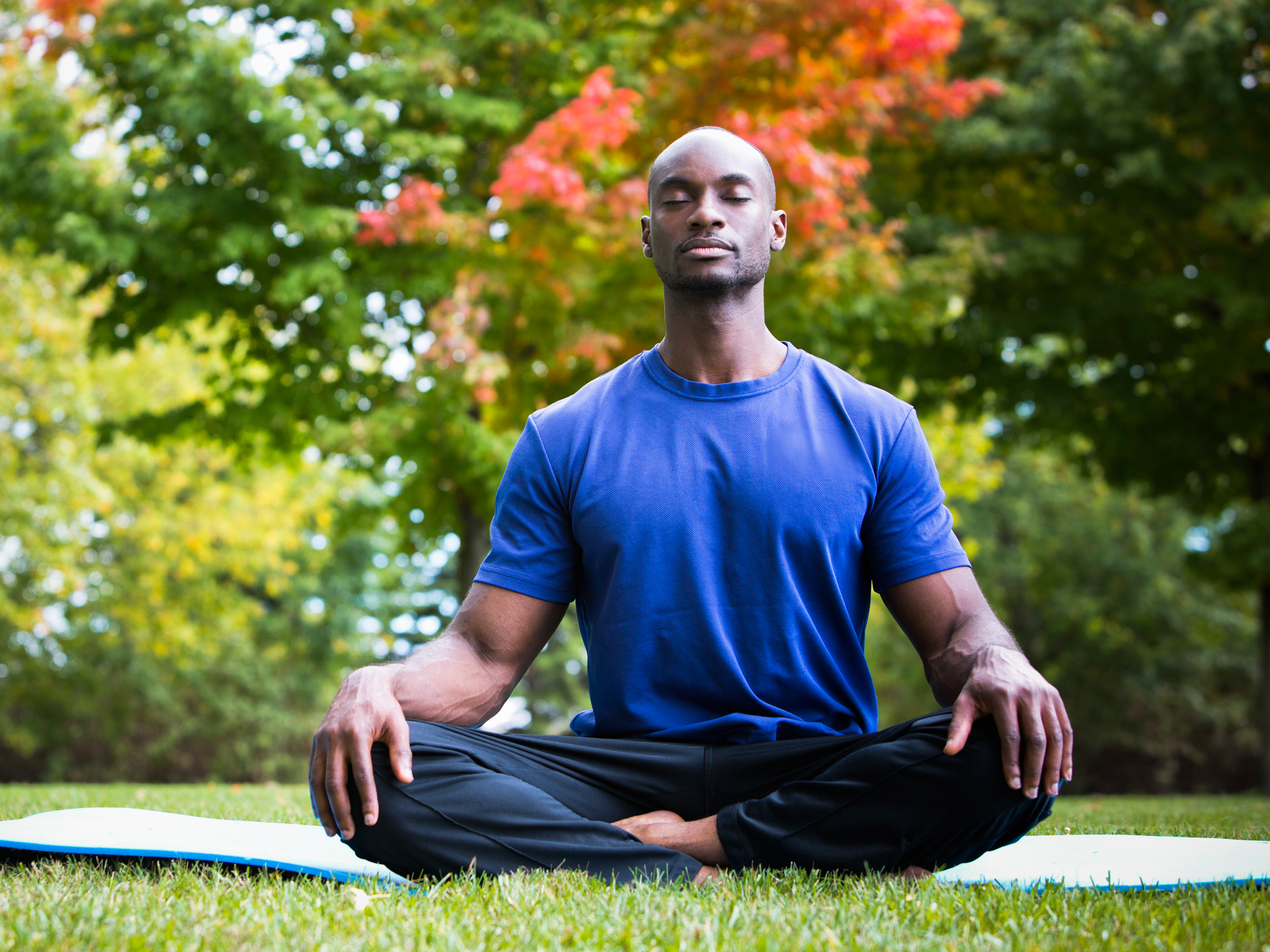Get Easy Health Digest™ in your inbox and don’t miss a thing when you subscribe today. Plus, get the free bonus report, Mother Nature’s Tips, Tricks and Remedies for Cholesterol, Blood Pressure & Blood Sugar as my way of saying welcome to the community!
10 ways meditation makes you better

What we think of as “normal” aging in our society is not really normal. It’s the psychopathology of a person who is totally stressed-out. My research indicates that meditating slows cell death, lowering your “biological age,” which dictates how you look and feel. It allows the body to heal itself. Start with five minutes every morning.
— DEEPAK CHOPRA, MD
In the last few years, meditation has been making its way, gradually, from the realm of the Buddhist, the hippie, and the yogi (and the hipster versions of all three) into the mainstream.
Hugh Jackman meditates. So do Rupert Murdoch, Bill Ford, Oprah Winfrey, David Lynch, Ray Dalio, Paul McCartney, and Jerry Seinfeld. Execs at Apple, Facebook, Nike, Google, and AOL are all promoting the practice in-house.
It’s all for a very good reason, and if you’re not on the meditation bandwagon right now, it’s time you considered it.
Why?
Meditation, research has shown, increases gray-matter density in areas of the brain associated with learning, memory, attention, and empathy. An article in the Journal of Neuroscience recently reported that in people who experience discomfort, meditation can reduce pain intensity by 40 percent.
Personally, though, I meditate for a much simpler reason: It quiets the noise.
High-functioning people have less noise
“Mental noise,” it turns out, may be one of our biggest obstacles to success. The National Science Foundation tells us that the average person has fifty thousand distinct thoughts per day. High-performers, however, have just eighteen thousand.
It’s the opposite of what we’d expect, isn’t it? We think that high-performers must be popping with ideas 24-7, and lesser mortals are slower thinkers. But if you look deeper, it makes sense. High-functioning people have less noise, less distraction, less self-sabotaging chatter, and more focus and concentration on their goals. The scattered brain constantly offers up options, wanting us to choose something; the focused, streamlined brain makes its choices more efficiently. Like a good coach or brilliant athlete, it’s in action mode. No time for too much naval-gazing.
You’ve probably had experiences that bear this out. When you’re stressed, the mind seems to race, desperately trying to come up with a plan. When you’re calm, your thoughts are clear, quiet, streamlined. The brain, says the performance coach Todd Herman, is naturally teleological — goal seeking — and when there is no goal, it races around like an overeager puppy looking for one.
Unfortunately, you burn a lot of energy this way.
Sometimes my “days off” are among the most stressful days of the week. My body might be relaxing or doing something enjoyable, but I can’t let go of some issue — personal, professional, financial. My mind keeps coming back to it, sniffing around the issue or just reminding me that it’s there and I haven’t dealt with it. At the end of the day I’m often more stressed-out and exhausted than if I’d spent the day working.
One of the best tools for distilling all the mind chatter — and one I’ve only recently discovered — is meditation. Sitting quietly. Eyes closed. Breathing. And thinking about… nothing.
Sounds simple, right? Yet people spend their whole lives perfecting this simple act. Stilling the mind. Focusing on the nothingness.
Benefits of taming the “monkey mind”
Many men (Westerners, in particular) find meditating extremely uncomfortable at first. Sitting (or standing, or lying completely still), without watching TV, listening to music, or intending to go to sleep, is an unusual endeavor for time-constrained guys in this age of constant intake and output of information. Why would I just sit still when I could be answering email, checking Facebook or Instagram, or texting one of my three hundred contacts?
The first time you try it, you’ll probably be astounded at the thoughts that race through your mind, and the frantic pace at which they come. Crazy, insane ideas, funny images, anxiety-producing scenarios. That’s your “monkey mind” or “untamed horse” doing its dance, trying to come up with ideas to divert your attention from simply being. Over time, probably in your first five-minute session, you’ll find a small place, perhaps by accident, where you’re not thinking. The monkey stops. Life, for a moment, seems simple. You accept it. You’re at peace.
It will last about one second, and you might not even notice it. But that’s what you want to build on. Really good meditators can stay there for hours. But even when you don’t pull off that nirvana state (and I myself rarely achieve it for very long), you’ll still get benefits, among them:
- reduced blood pressure
- reduced tension-related pain (tension headaches, ulcers, insomnia, muscle and joint problems)
- reduced negative emotions
- decreased anxiety and stress
- increased mood-boosting serotonin
- increased immunity
- increased energy
- better healing
- improved emotional stability and mental clarity
- improved creativity and happiness
That all sounds pretty awesome, right?
Some thoughts on how to meditate: You’ll see some longtime meditators sitting seiza (in a kneeling position) with their eyes closed, chanting or contemplating a candle or a flower. Others practice slow movements, like tai chi, qi gong, or yoga, while meditating. I encourage you to try all of these practices, and I know that the more you meditate, the more benefits you will receive. But also remember that you don’t need to make it the center of your life. You can meditate virtually anywhere or anytime: waiting at a stoplight, standing in a grocery line, riding the subway. You can meditate taking a walk.
The keys to a satisfying meditation
- Focusing your attention on your breath, a mantra, or some external, beautiful, inspiring object. This allows your thoughts to become clearer and quieter.
- Relaxing your breath, allowing your diaphragm to fully relax and expand your lungs. Don’t push too much for a deep breath — let the air come in and out naturally and allow it to slow as you relax more deeply. Remember to feel the rise and fall of your stomach — not your chest. If all that’s rising and falling is your chest, then you are not getting the full benefit of the breath — it’s constricted, most likely due to stress.
- Quieting down. Again — you can meditate anywhere, and practiced meditators can find a place of inner calm even amid chaos and extreme stress. In his book Dharma in Hell, the Zen teacher Fleet Maull talks about finding a place of inner calm while sitting on a bunk in a prison cell where he spent fourteen years with convicted murderers, armed robbers, and sex offenders around every corner. But too many noisy distractions can pull your attention outward, especially when you’re first beginning. Finding a quiet place is ideal.
- Getting comfortable. Don’t assume you have to sit in any particular way to meditate “correctly”: sit, stand, lie down, kneel, and shift when you need to. You can’t focus when you’re uncomfortable.
A little bit about my personal practice: I attend the Shambhala Temple in Orange County for weekly meditation, and I follow Sakyong Mipham Rinpoche, whose book Turning the Mind Into an Ally is a must-read for people wanting to go deep into meditation.
My personal meditation practice consists of a minimum of fifteen minutes, morning and night, following this template:
- Getting comfortable on my meditation pillow. I sit upright, legs crossed and hands on my knees, palms up. My posture is straight, which allows the breath to flow naturally. My mouth and jaw are relaxed, so breath can flow easily. My eyes are slightly closed and fixed on a point about two feet in front of me.
- Focusing on my breath. Like an ocean wave, the natural in-and-out flow of breath can be very soothing. But you can’t focus on it too intensely — or your mind will spin out into too many concrete thoughts. Nor can you be too relaxed, or your mind will get fuzzy. Breathe normally but always be conscious of the breath.
- Allowing thoughts to come and go. Thoughts will constantly come up — even the best meditators cannot avoid this. The trick, if such a thing can be said to exist in meditation, is to let those thoughts come and go. Recognize when they do and gently steer your attention back to your breath, allowing the thoughts to just float by, like a cloud.
- Being gentle. Meditation teaches you to be easy with yourself. So many self-improvement programs ask that you become a strenuous, effortful version of yourself. They suggest that you can do anything you want if you want it badly enough, work hard enough, focus more intensely on your goals. This is good counsel in certain contexts, but in meditation you do none of those things; instead, you allow yourself to simply breathe and be — rather than forcing yourself, out of habit, into action.
- Bringing the mind back to the breath. Each time you recognize that your mind has wandered away from the breath, and you gently return to it, your mind gets a little bit stronger. It’s like a repetition in the weight room. You’re building and strengthening a skill. So don’t judge or chastise yourself for having irrelevant thoughts any more than you’d judge a barbell for falling to the floor when you drop it.
Keep that up for ten to fifteen minutes, twice a day, and you’ll be on the path toward wisdom and compassion (not to over-promise or anything).
Meditation (which I just mistyped as “medication” — an interesting Freudian slip of the fingers!) has come to feel more and more profound to me as I’ve gotten older. I meditate in the morning as a way of staving off the frantic “ready, set, GO!” mentality that can descend on anyone who’s focused on taking big steps and living to his potential in the world. I’ll meditate for ten to fifteen minutes before bed as a way of slowing down and clearing out the mental clutter before I shut down for the night. And I’ll do more whenever I get a moment.
It’s a life-changer.
You can read more information about healthy living and peak performance as you age from Craig in his book: Your New Prime: 30 Days to Better Sex, Eternal Strength, and a Kick Ass Life After 40.













